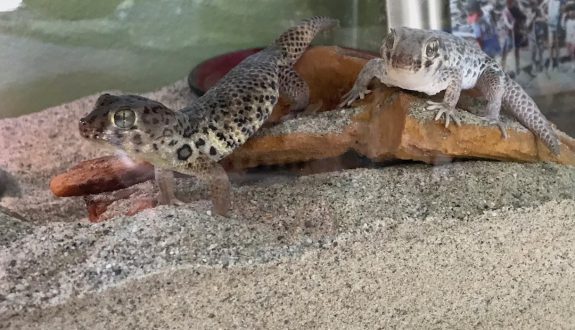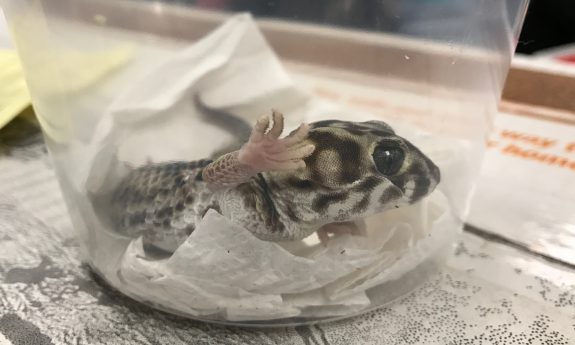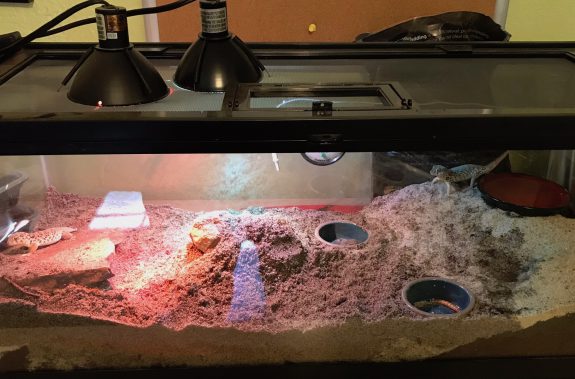As someone who has several Frog-Eyed geckos and is an avid reptile enthusiast, I find the extreme lack of information about this species to be very upsetting. Most of the “care sheets,“ and I use that term loosely, that I have found through my hours upon hours of searching are at their core a revised leopard gecko care sheet. the basics for any arid gecko species are present but very little to no information specific to the Frog-Eye is present depending on the source of the care sheet. In fact, you would be much better off spending a couple of hours on a gecko forum combing through hundreds of threads and comments than you would be reading one of these “care sheets” that I have mentioned. These geckos are not an especially difficult species token but they are extremely uncommon in pet stores and as pets.
I have only found one in a pet store that was brick and mortar…and that was a fluke on their part. My first Frog-Eyed Gecko was the Russian Frog-Eyed gecko and it was a chance encounter. The local pet store I go to had received her from one of their suppliers. I was just in the store to get food for a different animal but I walked out with her and an enclosure. Due to the lack of knowledge on this species, and the fact that most novice reptile enthusiasts would take a leopard or crested gecko over a frog-eyed gecko, the pet store was having trouble selling her so I got her for fifty percent off. Fast forward a year and I bought a pair of Tibetan Frog-Eyed geckos from a breeder that had them listed on FaunaClassified.
I currently own three Frog-Eyed Geckos. I have a Russian Frog-Eyed Female and a pair of Tibetan Frog-Eyed Geckos and am working on breeding the Tibetan pair. These species are hard to breed due to the fragility of the eggs (even though they are hard shelled). The humidity requirements are more specific than most Arid species of geckos and this is because of the way that Frog-Eyed Geckos absorb moisture. They should not be handled and are prone to dropping their tails. For all these reasons and more it is clear that a basic Arid Gecko care sheet does not suffice.
Through all my searching, literally hours and hours on the web as well as more than a dozen phone calls to various exotic pet stores, and my own experience with the species I have gathered a lot of knowledge about this species. I am writing this care sheet to condense all the information I have gathered and make things easier for novice gecko owners who find themselves with one of these amazing geckos, whether by accident or on purpose, to find accurate and detailed information. My information will be focused on Tibetan and Russian Frog-Eyed Geckos as those are the subspecies that I have personal experience with. The subspecies have various differences, most of which are neglible, and some will influence care. For example, my Tibetan Geckos prefer slightly cooler temperatures than my Russian Gecko
History
Frog-Eyed Geckos are the genus Teratoscincus. Russian Frog-Eyed Gecko’s are Teratoscincus scincus and Tibetan Frog-Eyed Gecko’s go by Teratoscincus roborowskii. There are four other subspecies Teratoscincus bedriagai, Teratoscincus keyserlingii, Teratoscincus microlepis, and Teratoscincus przewalskii. They are all desert species. They are also very distinct from any other gecko on the planet. Frog-Eyed Geckos have scales all over their bodies which aid them in absorbing moisture from the sandy environments in which they live. They are very small as well, rarely ever exceeding 6 inches. The subspecies differ in coloration and pattern as would be expected from geckos in different localities. My Teratoscincus scincus has a large head in proportion to her body and on her head has very dark brown coloration whereas my Teratoscincus roborowskii are more sandy in coloration and have very distinct spots on their necks with a more proportionate head. Their eyes are where they get their name and if you think of raptors from Jurassic Park, you have a pretty good idea of what their eyes look like. All subspecies of Frog-Eyed Gecko’s are burrowers.


Housing
If you have a single frog eyed gecko, a 10 gallon tank will be sufficient but a 20 gallon is better. For a pair or trio you must have a 20 gallon or larger. These geckos are very food aggressive and love to burrow. They are very active so despite their size, a larger cage should be provided. Another important aspect of housing this desert species of gecko is a heat gradient which is hard to achieve in a 10 gallon tank. I provide my pair of Teratoscincus roborowskii a 20 gallon long tank with 3 different hide areas throughout the tank, a small water dish, and 2 food dishes. My Teratoscincus sincus is currently in a 10 gallon tank with one large hide with two exits in the middle of the cage. To create a heat gradient in the smaller cage I use a very focused mini halogen heat fixture. When I get another Teratoscincus scincus I will upgrade to a 20 gallon tank just like I have for the Teratoscincus roborowskii.
Substrate
Without a doubt, the most difficult part for me when I began with Frog-Eyed Geckos was determining what sort of substrate to use, how much to use, which sand is good and which is bad, and you get the point. I spent hours searching the internet and talking to gecko experts to figure out which substrate to use. First off, DO NOT use repti-sand, vita-sand, or really any special sand in a pet store. Never use anything with calcium in it. This species of gecko needs a substrate that they can burrow in and that can hold the burrows. Clay based sand is definitely usable but you are going to have to order it online because practically any pet store you go to, all the ones I have gone to anyway, won’t have anything and if they do it won’t be safe in terms of ingestion and empaction. Exacavator clay can be used but you absolutely must add the water because if you use it dry and the Gecko eats the excavator clay it will expand in its stomach and kill it. Through my searching and phone calls I discovered something called Natural Reptile Bedding which is by far the best substrate I have ever used. Don’t take my word for it, go online or to your nearest Serpentarium and get a bag. Most substrates you find in a store are not made by breeders but rather by companies that have only profit in mind. Natural reptile bedding is made by one of the most experienced breeders in the US if not the entire world and he made it because there was nothing satisfactory on the market. You can use it for an extremely wide variety of reptiles and it won’t cause impaction in any reptile and you can raise babies on it. It is great for gravid females to lay eggs in. The reason I am spending so much time talking about this is because in my mind it is the only substrate to use for Frog Eyed Geckos. The only issue is that the only brick and mortar store I know of that sells it is The Serpentarium, but you can buy it on their website as well as through the manufactuer’s website. For my geckos I mix Natural Reptile Bedding 50/50 with washed play sand to a depth of 4 inches and for my pair I pack down Natural Reptile Bedding to a depth of 4 inches on the cold end of the tank with just a light dusting of play sand on top to encourage egg laying and allow for burrows. All my hides are buried to some degree or another in the substrate. I like to put 2 inches of substrate down, place the hides, and then put the last 2 inches in and shape it around the hides while I put it down.

Heating and Humidity
For my Teratoscincus roborowskii I use two mini halogen lamps (as you can see in the above picture) with a day bulb and a night bulb; both are 50 watt halogen bulbs. Depending on the weather patterns where you live you will have to adjust wattage, whether you keep the night bulb on at night or turn it off, etc. I live in a realtively cold area where night temperature during winter will drop below 40 degrees so I keep the night bulb on at night just to keep the temperature at 75 degrees. I have my day bulb on a digital timer and currently run it on a 9 hour cycle but really anything from 8-12 hours, depending on when you start or stop it, should be completely fine. I have the hot end ground temperature of the tank at 85-90 degrees during the day with the cool end being 76-81 degrees. The geckos will burrow, hide in caves, and find where they are comfortable, all you need to do is make sure they have a cool end and plenty of areas to burrow and hide under. I do not use a UVB bulb, but rather simply let the sun shine in through my window. UVB is not a bad thing, but I personally have not found it to be neccesary for my geckos yet. UVB is not required in my opinion because these geckos are only exposed to extremely low UVB levels in the arid regions of Asia which they come from. In addition they have very sensitive skin and so almost all commercially available UVB bulbs, especially in pet store chains, are going to be way too powerful and will end up harming them. In my opinion it is best to simply forego UVB all together. Frog-Eyed Geckos are also nocturnal and if given the opportunity will spend most of the daytime time in either burrows they dig or the hides you provide for them. I rarely see mine outside during the day unless they are getting water or going to the bathroom. If breeding doesn’t go well I might revisit UVB but I don’t anticipate any issues.
As far as humidity goes, they are a desert species and are adapted to absorbing moisture through their skin and as such need very little humidity. I would suggest simply misting the sand on the cool end of the tank lightly two days a week. This will be more than sufficient for the geckos. If you notice shed problems increase the amount of misting.
Feeding
I feed my geckos 4 or 5 days a week and adjust depending on weight. They will eat themselves into obesity if you allow them to so it is important to monitor their size and weight. I like to feed my geckos Dubia roaches and meal worms. I don’t feed my geckos crickets, although that is certainly an acceptable food choice, because crickets die quickly, smell, and can jump out of the feeder cups with ease. King worms and Dubia roaches will last practically forever and even smaller mealworms can be refrigerated to prolong life. Always dust your feeders with calcium and vitamin D3. I like the Rep-Cal brand but it is completely your choice. Personally I like to use Rep-Cal Calcium with VIT.D3 combined with Rep-Cal Herptivite.
Breeding
These geckos require a cooling period before breeding. They also need to be monitored carefully when gravid so as to get the eggs out before they are crushed by the geckos. Misting the cool end of the tank and providing burrowing substrate will encourage gravid females to lay eggs on the cool end. Their eggs are hardshelled but are very fragile. They do require humidity while incubating and placing a bottle cap with water in it with the eggs should accomplish this. However, always monitor the eggs carefully.
Other Considerations
These geckos are very cute but should not be handled unless absolutely necessary. They are easily stressed and when held while either drop scales or their tail. If you want a gecko that you can handle frequently you should not get a Frog-Eyed Gecko.
Do not house different subspecies together unless you are able to monitor them carefully. They are not likely to get along and may even attack and kill each other.



Great care sheet much needed
Did you try to use glass sand?
No I have not. Nearly all commercially available sands are risky to use mainly due to ingestion. Natural Reptile Bedding is proven to be safe and so I see no reason to use anything else. Also Frog Eyed Gecko’s need to be able to burrow if they want and just plain sand won’t allow burrows.
Previous owner of my frog eyed geckos held them on sand, so do I, yes, they eat it, but all sand goes throgh the organism without problems) by the way, i am from Russia and there are no such beddings here(( some keepers advise to mix sand and soil as well
My daughter bought a frog Eye gecko for a friend and it has dropped its tail. Will the tail grow back and is there anything that they should do in particular? I found your article interesting because the pet store we bought it from told them to hold it from a young age and it would enjoy being held and they hold the gecko frequently.
Hopefully the author will respond soon with an answer to your question about whether the tail will regenerate. Some geckos do regenerate their tails, gargoyles, for example. Others, such as crested geckos, don’t. In general, just leave it alone and don’t handle it too much and the tail area will heal and possibly regenerate. I’m not familiar with frog eyed geckos, but among the geckos I do have, some of them of the same species as each other tolerate handling and some hate it. I had a crested gecko that dropped its tail when I picked it up, while another of my cresties is fine with being held.
Hi Michele,
That’s a great question and as Aliza stated some species do and some do not. Luckily for your daughters friend Frog-Eyed Geckos will regenerate their tail. My Russian Frog-Eyed gecko (the picture of the one in the cup) actually dropped her tail when I was attempting to move her so I could clean the cage. It took about a month I would say before it fully grew back and the tail that grows back will be gray and not the same color as it was before. There really isn’t anything you need to do, just give the gecko space and don’t handle it. If there is anything on the end of the tail like substrate you can try and get it off with something like a q-tip but if you’re not comfortable with that it isn’t necessary because when the end dries it will come off naturally.
As far as the employees of the pet store go, that is generally good advice for most geckos because holding them from a young age helps them to be more comfortable with you as time progresses although I would always leave them alone completely for 2-3 days while they adjust to their new surroundings. However, Frog-Eyed geckos have a different skin then any other geckos (to the best of my knowledge) in that they have actual scales, sort of like fish, which are an adaptation to absorb water in very dry environments and those scales come off extremely easy. On top of the scales coming off they are very high energy and nervous geckos, handling will put a lot of stress on them. It definitely is possible to hold them and someone who has a lot of experience with geckos can certainly do so without anything more than stress occurring but they are definitely a display animal and not one that should be handled more than absolutely necessary. Most stores that I have talked to about these geckos have never heard of them or, if they have, have never kept one. The Serpentarium’s gecko expert has never owned one. So most places will give you a very generalized care sheet for them that is very similar to that of a leopard gecko.
The good news is that the tail will grow back! These geckos are very cool to watch and have a lot of character!
If you have any other questions feel free to contact me at my email [email protected]
Sincerely,
Tucker
Great article! I think frog eyed geckos are some of the cutest geckos there are(2nd place behind smooth knobtailed geckos. I was looking online and I couldn’t find the natural reptile bedding.Could you say how to get it?
Also I live in the UK so if it was in £ that would help a lot 🙂
My frog eyes gecko have problem with her scales. The sacles come off when i handle her. Can her scales turn back ? And how long does it take ?
Adam,
Sorry for getting back to you 8 months after your original reply, I didn’t receive an alert or perhaps it got lost in my email. As far as purchasing in the UK I am not entirely sure if any of the online retailers that sell NRB would ship to the UK. However it is worth a shot and I am including a link to the Lugarti website, which is the company that manufacturers it, list of online retailers http://www.lugarti.com/content/7-lugarti-online-retailers
Hope this helps,
Tucker
Hello I’m using a nano halogen day time bulb that’s 25w. I live in Texas so it doesn’t get that cold at night right now. Is the 25w alright to use. She’s in a 10 gallon at the moment till I can acquire a 20 gallon. She’s a Russian frog eye. Thanks
Hi Allyson,
Sorry for my late reply. I did not get notified of your comment. As far as wattage, all that matters is that the temperature is in the right range in your terrarium. Of course, in a 10 gallon you won’t really be able to get a gradient going and with it being small I would 25 watts would probably be okay especially during summer. However I would always recommend using a thermostat to regulate the temperature and of course don’t leave a day bulb on during the night.
Thanks for the article Tucker, how often should a sand substrate be replaced? I have a soft non-abrasive fabric mat alomg the floor of his enclosure but is the inability to burrow or play in sand making him depressed?
I cant imagine replacing the natural reptile bedding without stressing him out.
These days he doesnt eat and will lick his lips a couple times when i place a worm in front of his face but nothing more. He is between 3 and 4 years old.
I usually feed him a repti-cal vit D3 dusted superworm every other day and let it wander in his enclosure and he is uaually quick enough to gobble it up. As well as the occasional cricket instead but he rarely ever eats the cricket anyway. Id love to feed him dubia roaches but nobody in canada seems to sell these.
I turned off my daytime UVB bulb as per your suggestion.
Its a ten gallon tank with two hides and the natural reptile bedding only ships to the US but i will keep checking amazon, he looks sad not being able to do much burrowing
Hello, I have a pair of frog eye geckos in a 20L. When I got them the pet store was not sure of the sex. But told me they got along well. And they sure did. I soon realized I had a female when she laid eggs. But I was unsure if the second was a male or not. But in case he was I removed the eggs as I did not wish to have babies. However, I must have missed one because a while after I had a little baby running around the tank. Surprise I got my answer! So my question is can I leave the baby in the tank with the parents or do I need to remove it? I know geckos tend to abandon their eggs after they lay. But I am not sure if they will hurt it or not. Thanks.
Hi Jessica, congratulations on the baby! Definitely remove the baby from the parents tank. The parents will likely be aggressive towards it and could very possibly kill it if the baby is left with them.
The baby can be kept in a 5-10 gallon tank while it is still small.